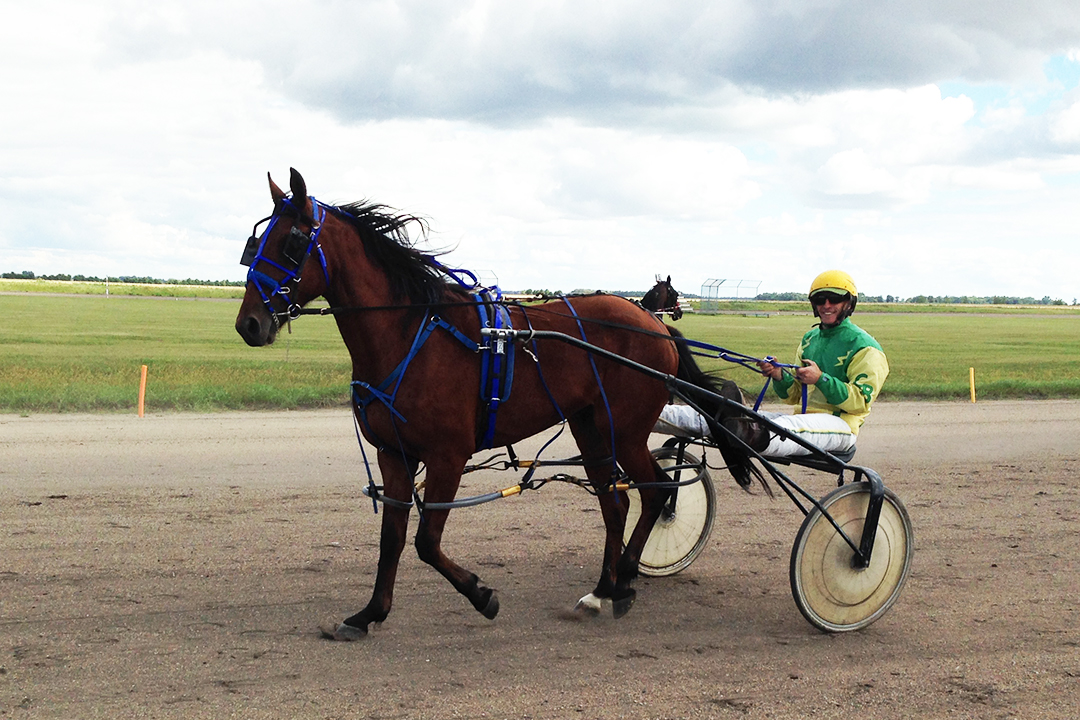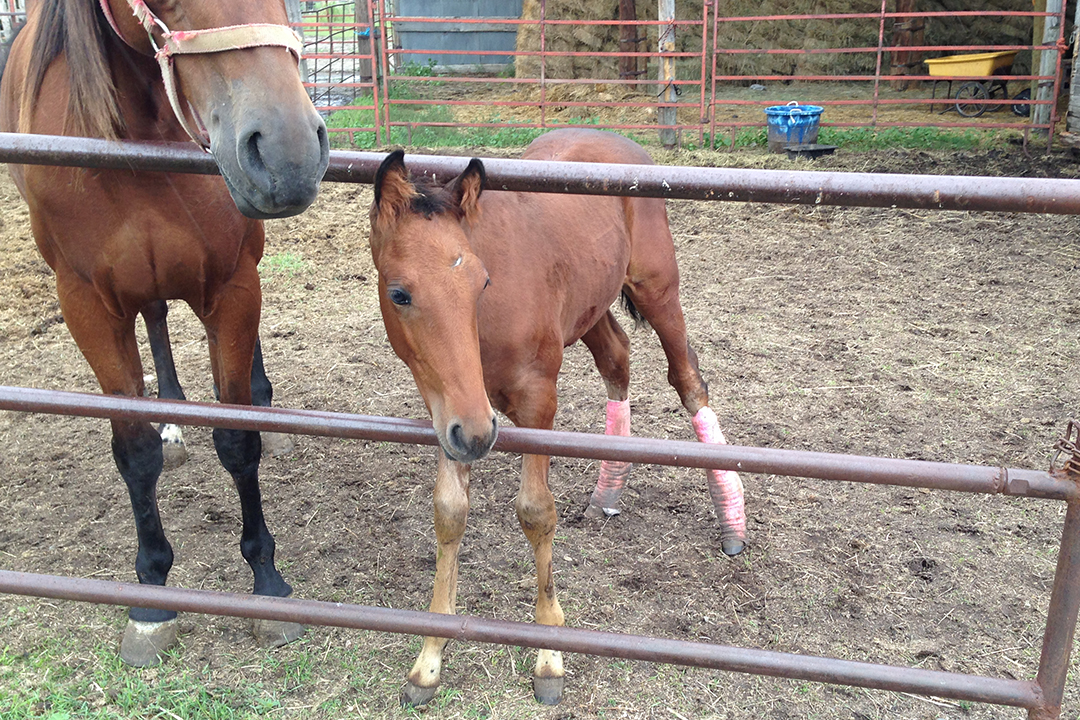
'One tough horse'
It was one of those mystery injuries every horse owner dreads: Glenda Giles found the one-month-old colt, out of her favourite Standardbred mare, with a badly scraped hind leg. Since her husband, Clayton Braybrook, was away harness racing in Manitoba, it was up to Giles to take care of the injured foal named Sonny.
By Christina WeeseGiles didn’t know things were about to get much worse.
Sonny and his dam were on the family’s small farm near Kindersley, Sask., where they keep their mares in the summer. Needing to doctor the foal, Giles led her mare to the pasture’s tin-covered shelter so she could catch the foal. But when Sonny backed into the corner of the shelter, he spooked and put his good hind leg into a gap between the building frame and the tin siding. When he went to pull it out, a sharp tin edge carved into his leg to the bone.
Giles immediately knew it was an emergency. She called her friend and neighbour, Glenda Hawken, an assistant at the Kindersley Veterinary Clinic. With a pressure bandage applied to stem the bleeding, some stitches and a referral from veterinarian Dr. Andrew Klebek, Giles loaded the mare and foal into a borrowed trailer and brought them to the Veterinary Medical Centre at the Western College of Veterinary Medicine (WCVM) in Saskatoon, Sask.
“The story goes that they [WCVM clinicians] cut off the bandage and said, ‘Oh, that doesn’t look good,’” says Braybrook with a wry chuckle.
“The wound had opened the back of the fetlock joint but also affected the tendon sheath, meaning two heavily- contaminated synovial structures, which is never good,” says Dr. James Carmalt, a professor in the WCVM’s Department of Large Animal Clinical Sciences and lead surgeon on Sonny’s case.
Sonny’s injury had exposed bone, missing bone lining, and two small fractures contaminated with hair and debris. Due to the debris, Carmalt was forced to remove a fractured piece of bone during surgery, which left a fairly large defect in the joint. With the wound closed, the joint and tendon sheath flushed, and a course of antibiotic drugs started, everyone crossed their fingers.
Equine surgeon Dr. Travis Smyth, who was a WCVM large animal surgical resident at the time, was also part of Sonny’s clinical team. Neither he nor Carmalt had ever seen anything like Sonny’s injury before, but that didn’t deter Sonny’s owner.
“One of the things that stands out in my mind was, despite the poor outlook, Clayton stayed positive throughout,” says Smyth. “He said he really liked the foal and had to do anything he could.”
Two days later, while he was still recovering in the WCVM’s Large Animal Clinic, Sonny went lame due to an infection in the joint. But this time, his clinical team could choose antibiotics that specifically targeted the bacteria growing in the foal’s wound.

“The first antibiotics we chose were our best guess,” says Carmalt, adding that it usually takes 48 hours for the clinical team to receive lab results. “We changed antibiotics when we had an ID on the bacteria, and flushed the wound and tendon sheath a second time. That’s not uncommon with a heavily contaminated joint wound.”
After about a week in the clinic, the foal was discharged into Braybrook’s care, who trailered Sonny and his dam to the family’s training farm in Virden, Man.
“He was never out of my sight,” says Braybrook. “He wore bandages every day of his life from the time he was a month and a week old.”
By the year’s end, it was clear that Sonny was going to make it, and Braybrook realized the deadline to register Sonny as a racehorse was looming — the colt needed a racing name. Braybrook, who was formally trained as a band leader and plays all kinds of instruments, was teaching a music lesson when inspiration struck: Appoggiatura.
“It means ‘the chord or note that turns sweet’ — an awakening of harmony from dissonance,” says Braybrook.
Harness racing is often a family affair, and Braybrook’s farm is no different: he and Giles and their family raise, train and race their own horses.
“My dad was the best of the best,” says Braybrook. “He could get a donkey to race.”
When it came time to break Sonny to harness, Braybrook was the one who took the reins.
“We just put the harness on, and he started pacing free-legged on his own,” he says. “I was real careful with him, always watching for inflammation, heat, if he favoured [his leg] at all.”
Sonny was started as a two-year-old, with no pressure to race right away. By the end of the summer, he was schooling behind the starting truck.
“He handled [it] like a pro. That gave me the sense that he might make it as a racehorse after all, which he proved in the next two years.”
Sonny raced as a three- and four-year-old with Braybrook as his trainer and driver. In late 2018, Sonny began racing on Alberta’s winter circuit — initially with Jamie Gray and then with Steve and Shannon Crump. His fastest time is 1:56.1 for a mile, and to date, his lifetime earnings are over $33,000.
But it’s not Sonny’s winning ways that have won Braybrook’s heart. “He’s just a real sweetheart. Just a pet. He gives kisses, comes running to you when you go out to the gates. Those surgeons, they’re the best in the world, and we also want to thank God, because we think he’s our own little miracle.”
Carmalt says Sonny’s full recovery is a positive message for horse owners: “Even with relatively scary wounds, these young foals can go on and do extremely well.”
In Sonny’s case, a fast referral and supportive owners tipped the balance in his favour.
“[We] can tell other clients with the same injuries that good things can happen, it’s not the end of the world — you just have to be willing to invest time and money,” says Carmalt.
Smyth, who grew up in Merritt, B.C., and now practises in Australia, has kept in contact with Braybrook over the years to check in on Sonny. He says his own role in Sonny’s success was small.
“In my opinion it comes down to James [Carmalt] being an incredible surgeon, Clayton being a singular one-of-a-kind person, and Sonny being a tough little horse.”
What he has learned from Sonny’s case is that anything is possible: “We often associate a poor prognosis with ‘no chance.’ There is always that exception to the rule.”
